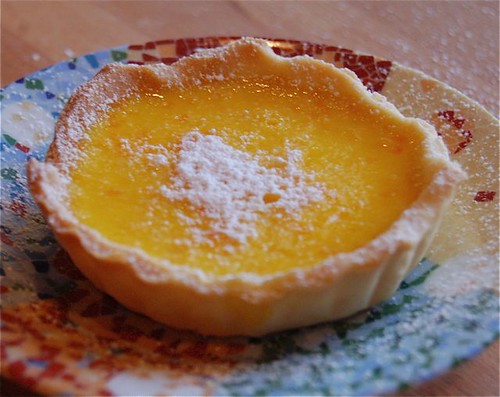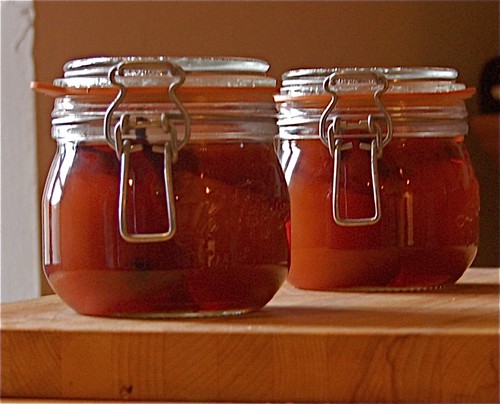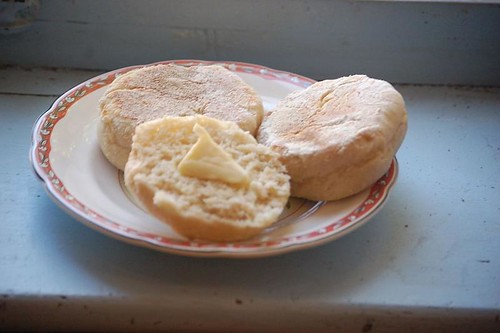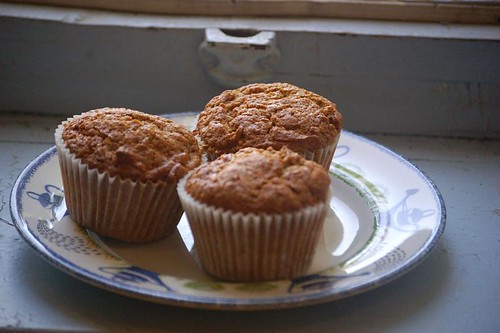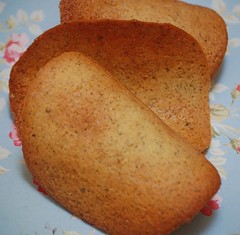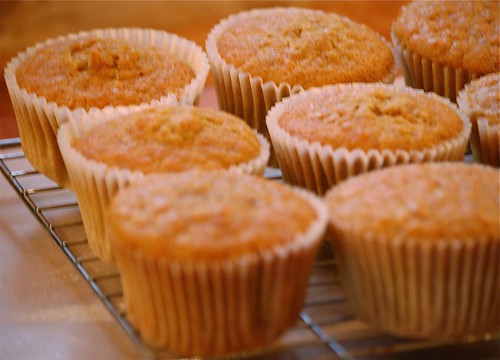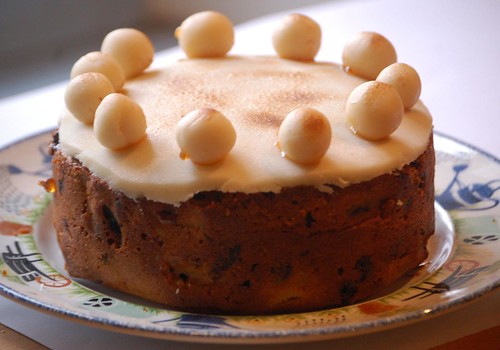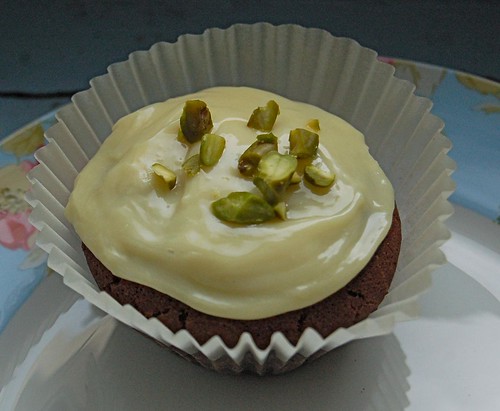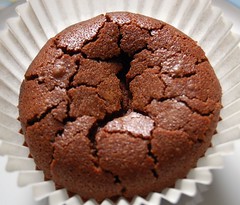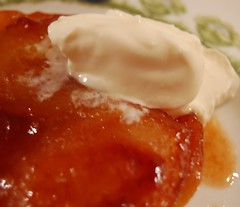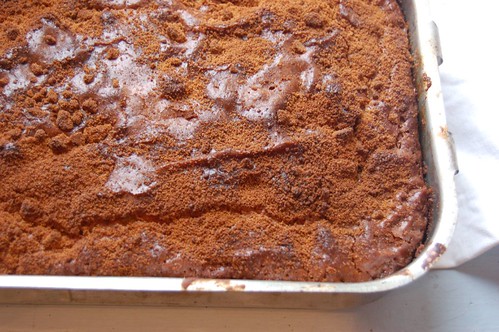Some left-over pastry from a tarte au citron, newly acquired dinky silicon tart cases — I quickly improvised these charming little tartlets with ingredients I had to hand. Makes six tiny tarts or four larger ones. You could of course use lemons instead of orange, adding a bit more sugar.
Read More
Category: Baking
Enjoying other people’s food: Belgian pears and pumpkin cake
I’ve enjoyed a few things from other people’s blogs recently, and these two recipes are definite keepers.
First, Fiona’s Belgian pears. I made a mental note to try these ages ago, prompted by the rave reviews on her blog. When I looked more closely, the ingredients and method looked really strange — cook pears in vinegar and sugar for six hours??? Wouldn’t they be reduced to mush? But I have absolute faith in Fiona’s tried and tested recipes, so small pears from the market at 90 centimes a kilo seemed a good opportunity to try it. They sat at a bare whisper of a simmer on top of the woodburner, and the small amount of vinegary liquid slowly transmuted into a quantity of mahogany coloured syrup. After five hours, we tentatively tried a couple of the very soft pears with a little of the liquid and a blob of crème fraîche. Wow, they were good! As Fiona says, they taste alcoholic even though they are not. And they look most impressive bottled — they would make lovely Christmas gifts.
Although I hesitate to vary from Fiona’s tried and tested recipes, to be honest (having done two batches now) I think you could cook them for less time. You have to handle them very, very carefully when bottling because they are so soft after six hours, even at an almost invisible simmer. The necessary juice is produced during the first three hours’ cooking. So I think the uncovered simmering could easily be reduced to two hours without detracting from the final result.
Next up, the weekly conundrum of the pumpkin in the veggie box. The Open University group of foodies came up with loads of ideas, and one of them caused me to google “pumpkin and carrot cake”, which brought me here. Yes! My somewhat amended recipe follows — no photo because the light wasn’t good and the icing was a bit of a disaster. But you can always look at the photos on Meeta’s post. The cake is dense, with a lovely spicy flavour, and a dark brown colour from the sugar. Good with or without the frosting. Oh, and if you don’t have any pumpkin I am sure it would be just as good with carrots alone.
Breakfast: muffins two ways
Another glut of carrots in the veggie box. I almost made Ivy’s lovely carrot cupcakes again. But then I realised I could knock off another recipe from Delicious Days, so I made Good Morning Muffins instead.
These are American-style muffins with toasted ground hazelnuts, grated carrots and some sliced apple. Verdict: they were OK, but I’d rather have made Ivy’s cupcakes! It has to be said I’m not that keen on American muffins. Still, it means we have something different to eat from breakfast instead of terminally boring wholeweat cereal.
Meanwhile, I also decided to have a go at making English muffins. These are something we do occasionally have for breakfast because you can get acceptable packaged ones in Carrefour. But I thought it would be nice to try making my own so I could put them in the freezer and have them whenever we like.
I’d always thought muffins were tricky, but I found a recipe at King Arthur Flour that looked utterly straightforward and even let me dust off the bread machine to make the dough.
I had to do some conversions and the initial batch turned out rather wet, resulting in oddly-shaped muffins, because the dough stuck to everything and was difficult to transfer from work surface to griddle. But I just added a bit of flour to the remaining dough and they turned out beautifully. I cooked them on my electric plancha, which is perfect for this and means you can cook them eight at a time. I split one and spread it with butter the minute it came off the griddle — yum! No more bought muffins for me!
Following is my converted recipe. If you don’t have a bread machine there’s a manual version here — though I’d have thought that with a bit of common sense you could simply make the dough in the recipe below by hand.
Update: my bread machine finally packed up. Now I make these in the stand mixer, using the flattish beater (not the dough hook). Just beat at medium-high speed for 5 minutes till the dough is stretchy, then leave to rise in the covered bowl for a couple of hours before continuing as for the bread machine method.
Read More
Earl Grey tuiles
I am an habituée of tuiles, since they are my go-to solution for an excess of egg whites. So this recipe from Delicious Days held no terrors for me. I had 6 egg whites in the fridge from making a prune and Armagnac tart, so this was a good opportunity to try them.
The paste was a bit more solid than I normally make, so they were slightly thicker than usual, but still crispy. And flavouring them with lemon zest and powdered Earl Grey tea is an inspired touch. They had an exotic perfume, and made a nice change from plain ones. Tuiles make a great accompaniment to any creamy dessert. If you shape them over cups or small ramekins, you can use them as containers for a filling of your choice — or just a scoop or two of ice cream.
Carrot cupcakes with maple cream cheese frosting
The other day Steve bought about a kilo of organic carrots when I only needed a couple. So I was searching around for ways of using them up. I almost made Ivy‘s carrot cupcakes, but I didn’t have any oranges, so I decided to try something different. I ended up with this recipe from Smitten Kitchen, but as so often with American cake recipes I ended up changing it so radically it was hardly the same recipe by the time I’d finished. The result was quite different from Ivy’s cakes, but equally delicious. I loved the spices, especially the ginger (I’d even add a bit more next time), and the cakes were both light and moist.
It was yet another cake recipe that specified 2 cups each of flour and sugar. Hey people, a cup of sugar weighs about twice as much as a cup of flour! I like my cakes to taste of something other than sugar, especially when they are topped with tooth-achingly sweet frosting. So I decided to go for pound-cake ratios — equal weights of sugar and flour — reducing the sugar content by half.
The recipe uses vegetable oil instead of butter. I thought this was a bit odd, but we’ve been eating an awful lot of saturated fat recently, one way or another, so I decided it was time for a change. Again, 260 ml of oil looked like a lot, so I reduced it to 220, and I think I could even have used a little bit less without ill effect. If you want, you can replace all or part of the oil with softened butter.
And finally, instead of the raisins and walnuts, I used some chopped candied orange peel. But I think they might have been even nicer with chopped candied ginger as well or instead (can you tell I really liked the ginger flavour?).
This recipe makes a large batch; I used muffin tins and got 16 cakes out of it, but they would have been better a bit smaller. I frosted them with Ivy’s mascarpone frosting, except that I added maple syrup to it instead of lemon zest.
Read More
Simnel cake
I really like fruit cake and marzipan, but I’ve never made a Simnel cake before. These are traditional in the UK at Easter, apparently since Roman times, and the 11 marzipan balls on top are supposed to represent the 11 apostles (minus Judas).
The recipe I used comes from a guest post from the Mildred Mittens Manufactory on the Cottage Smallholder, my favourite blog and always a reliable source for recipes.
Mildred is obviously a one-woman cake-baking factory. Her recipe makes two or three cakes depending on size, so I adapted it slightly, since for one thing I only have one suitably sized cake tin. I halved the recipe and then converted it to metric since my scales don’t do pounds and ounces. Note: if you are doing this with a recipe, always sit down and do the sums on paper first, then check your maths, and keep the paper by you when you are measuring. I have messed up a couple of times by doing this in my head as I go along and forgetting to halve some vital ingredient!
Then I twiddled the fruit a bit to suit what I had: no glacé cherries, so I used a mixture of sultanas, raisins, a few chopped dried apricots and prunes, candied lemon and orange peel, and dried cranberries. Then in a flight of fancy I popped in some diced candied papaya. We don’t give sweet sherry house room here, so instead I soaked the fruit overnight in lemon juice and a glug of Monbazillac — it smelled gorgeous while it was soaking. Oh, and I didn’t make my own almond paste — you can buy very good soft marzipan here, so I used that.
If you want the original recipe in pounds and ounces, pop over to Fiona’s blog. If you want to see loads of cute photos of guinea pigs and hedgehogs, visit Mildred’s site. Otherwise, read on for the recipe.
Read More
Spanish orange cake
I don’t know what is specifically Spanish about this cake, but we enjoyed the moist texture and fresh orange flavour. Both times I’ve made it, it has sunk a bit in the middle on cooling, but this does not detract from it in the least!
We had it plain, but you could make a simple glaze by mixing orange juice and icing sugar to the right consistency. It would probably make nice cupcakes too.
Read More
Chocolate mini cupcakes
These, from my Delicious Days cookbook, were fabulous. The ultimate test — how quickly they were snaffled at choir rehearsal, and how many people asked me for the recipe.
Mind you they should be good: 200 g each of dark chocolate and butter, 250 g of sugar, and 5 eggs! To be fair this did make 18 little cakes. The mixture is an almost flourless sponge (just 3 tbs of flour) and is intensely chocolatey. Nicky ices them with white chocolate and a sprinkle of chopped pistachios. I didn’t get a chance to do this with most of them (they were eaten too quickly) but in the interests of research I tried it with one of the two that I had saved for photography. I think they are better without: they have a very thin slightly crackly crust over the melting interior which is swamped by the icing.
You can make this as one large cake too, in which case it would make a special dinner party dessert served just warm with a pool of chilled crème anglaise or a small scoop of vanilla ice cream.
Tatin round-up
Tatins seem to be everywhere these days; first Bellini Valli of More Than Burnt Toast, then Loulou, then Ivy came up with their own versions. I saw Ivy’s post just as I had got home with a big bag of apples to make one myself. At a stroke, I tried Ivy’s idea of making small individual ones, using some perfectly-sized shallow gratin dishes. A great idea for anyone nervous about flipping the tatin; it’s much easier with small ones! I think I’ll be making these a lot now, although there is something impressive about a single large tarte tatin fresh from the oven, glistening with caramel and just waiting to be shared with friends.
Finally, if you are really, really nervous about making tatins, try this unconventional method from Zen Can Cook — the results look stunning, and that’s exactly the colour you should be aiming for — though personally I would not use puff pastry.
Once upon a time, tarte tatin meant apples, but now it’s come to cover a much broader spectrum, from sweet to savoury. Some of them are a travesty of what tatin is about in my opinion; it should be simple, not tricked-up with loads of extra ingredients, and the essential point is that whatever you use should caramelise to a rich golden brown; if it doesn’t, what’s the point? Things that produce too much juice or go soggy/disintegrate will not work. Whatever you choose, you must be brave and caramelise it to within an inch of its life; it must be deep golden-brown before you put the pastry on, otherwise your finished tart will be pale and disappointing. So that said, here are a few ideas:
- To a classic apple tatin, add some thin slices of quince for a wonderful added aroma, or mix pears and apples. I always add some grated lemon zest and a squeeze of juice to mine.
- Try a pineapple tatin; it works really well, and is a good use for a fresh pineapple that isn’t as flavourful as you had hoped. Peaches and apricots are good summer candidates too.
- On the savoury front, tomato tatin is obvious and excellent; either one large one as a main course with salad, or small individual ones served as starters.
- Shallots make a fabulous tatin: caramelise whole peeled shallots slowly in butter or olive oil with a sprinkling of sugar, and add some balsamic vinegar at the end. For the ultimate taste and texture sensation, make individual ones, turn out, and top each with a slice of pan-fried foie gras. This is sinfully good!
Crater banana bread
Domestic crises chez Nicky meant a hiatus for Taste & Create last month, and I’m pleased it’s back this month, thanks to Min, while Nicky takes a much-needed break.
My partner was a new one to me: Allison of Fridgg. First impression when I landed on her blog: “Wow, those photos are amazing!” Second impression: “Spam musubi?? Help! I don’t like spam and I don’t like sushi!” It’s all very well going out of your comfort zone, but this was a step too far 🙂
But undaunted, I continued searching, and my persistence was rewarded. Back in August, Allison had made a yummy-looking crater banana bread, and glancing at the fruit bowl I saw a ripe banana just waiting to be used. I’ve actually never made banana bread, so this was a first for me. I still felt at liberty to change it though. I’m not a fan of chocolate chips, in fact I don’t really go for chocolatey desserts unless they are made of large quantities of the best bitter chocolate. Or they are the milk chocolate soufflé at Lapérouse in Paris — I thought I’d died and gone to heaven when I ate that. Bananas say “rum” to me, so I substituted some rum-soaked jumbo sultanas for the chocolate chips.
It smelled fabulous while it was cooking, and I could barely wait for it to cool down before I tried some. I had wondered why it was called “crater” banana bread, but the crackled top did look like solidifying lava when I took it out of the oven. As for the end result, well, now I know what to do with over-ripe bananas. The inside was quite moist and the sultana layer had sunk to the bottom, making a gorgeously gooey, caramelised mess, but the edges and top were crunchy and caramelised, making a lovely contrast with the crumb. It’s so rich, more like cake than bread, that it’s probably most appropriate as a dessert, slightly warm, with ice cream or yoghurt. “I don’t like banana bread,” said Steve, and then had second helpings.
My metric version follows: this time I did stick to the quantity of sugar specified, even though it looked a lot, and double-checked all my conversions. Mine is also for a smaller cake than Allison’s.
As for the photos, well, it just wasn’t a good day, but don’t let them put you off!
Read More
